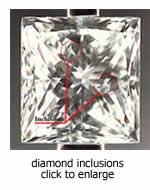Diamonds - The 4 Cs
Clarity
 Clarity
is the term used to describe the internal quality of a gem. A trained expert
examines the diamond for inclusions, cracks, spots, clouds, or any other blemish
or imperfection of any sort. Usually blemishes cannot be seen with the naked
eye but can be detected under 10-power magnification.
Clarity
is the term used to describe the internal quality of a gem. A trained expert
examines the diamond for inclusions, cracks, spots, clouds, or any other blemish
or imperfection of any sort. Usually blemishes cannot be seen with the naked
eye but can be detected under 10-power magnification.
Clarity Grading Levels
The Gemological Institute of America (GIA) recognizes 10 grading levels for clarity. Other qualities being equal, the lower the clarity grade, the less valuable the stone.
- IF - Internally Flawless
Free of flaws, cracks, spots, clouds, or any other blemish or imperfection of any sort when examined under proper light by a trained eye with the aid of a diamond eye loupe or other magnifier with a magnification of at least 10 power. - VVS1- Very, Very Slightly Imperfect (1)
The gem may have a very tiny pinpoint of included material, cloud, polishing line, or faint knot line, but only one of these blemishes and it is very faint to a trained eye under 10X magnification. - VVS2 - Very, Very Slightly Imperfect (2)
Inclusions may be the same as for VVS1, but slightly larger and more numerous. They are still very hard to see. - VS1 - Very Slightly Imperfect (1)
The gem may have minute internal cleavage or fracture (feather) near the girdle, or it may have any of the above blemishes, slightly larger but still fairly difficult to detect under 10X magnification. - VS2 - Very Slightly Imperfect (2)
Any of the above inclusions are more easily visible under a 10X loupe. An included crystal or other small blemish may be seen through the crown. - SI1 - Slightly Imperfect (1)
The diamond has a cleavage fracture or any blemish or combination of blemishes not visible to the unaided eye but easily seen under 10X magnification. A small dark spot in the center of the stone or a larger white flaw toward the edge would be graded SI. - SI2 - Slightly Imperfect (2)
The diamond has slightly larger inclusions than grade SI1, but they still are not visible to the naked eye when the stone is face up.
(NOTE: There is no such thing as a GIA grade of SI3. Such a stone is really just an I1 grade.) - I1 - Imperfect (1)
Inclusions are just visible to the eye without a loupe. - I2 - Imperfect (2)
Inclusions are easily seen with the unaided eye. - I3 - Imperfect (3)
This grade denotes a badly flawed diamond with cleavages, fractures, large clouds, and dark spots large enough to block light passage and destroy brilliancy. This grade of diamond would be inappropriate for jewelry.
Excessive inclusions or fractures not only make the diamond unattractive, but may weaken its strength so it is more likely to crack. However, flawless diamonds are extremely rare in nature. One expert points out that no two diamonds are alike, and that inclusions in a particular stone are like its fingerprint, identifying it among all others.
Shopping Considerations and Caveats
- Diamonds often undergo treatments to conceal fractures and improve clarity. Since they may disguise a lower quality gem, diamond treatments should always be disclosed.
- "Clarity enhancements" are diamond treatments that improve the appearance of the stone (to the naked eye). Read about gem treatments to understand their purposes and their shortcomings before you shop for jewelry.
 Buyer's
Tip
Buyer's
Tip
When pricing diamonds, ask about gem treatments. When making a purchase, be sure to get in writing either that the gem is untreated or that it has been subjected to specifically named treatments, such as laser drilling or fracture filling.
The other 3 Cs...
Carat Weight
Color
Cut proportions
